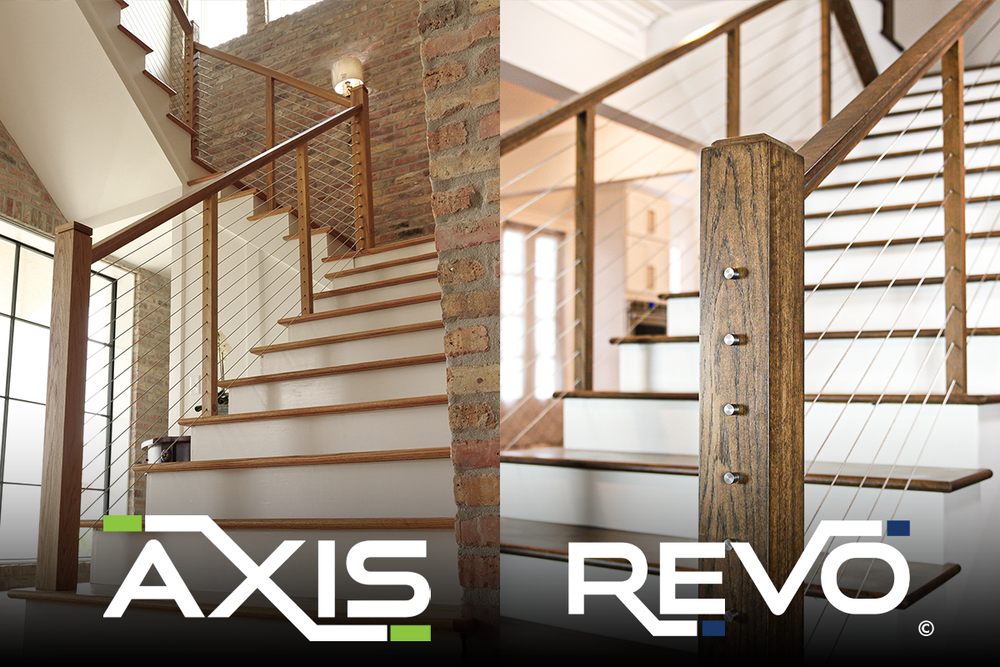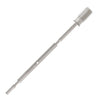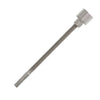How does a cable railing system work?
Cable railing systems consist of several rows of tensioned cables that are suspended between the posts in a handrail. At one end of the cables are end stops, which hold in the cable in place at a termination post. From there, the cables pass through intermediate support posts and then are secured at the opposite end by a tensioner which applies tension to the cable. If you’d like to learn more about the basics of cable railing systems and how they work, then we recommend watching our video covering cable railing basics on our HAAS Stainless Cable Railing YouTube channel.
What type of material are HAAS Cable Railing Systems made from?
HAAS Stainless cable railing systems are made from high quality Type 316 Marine Grade Stainless Steel.
What are the building code requirements for cable railing systems?
The national building code requirements for cable railing systems states the following:
- Hand Rail Height: 36”-42”
- Cable Spacing: Cables should be spaced no more than 3” apart, so that a 4” sphere cannot be forcefully pushed through the cables.
- Post Spacing: Posts in your cable railing should be spaced no more than 4ft in between each post.
Does stainless steel cable railing rust?
Contrary to popular belief, stainless steel cable railing systems can potentially rust when they are not maintained properly in saltwater environments. For more in depth information regarding cable railing maintenance in saltwater environments be sure to check out our video and blog posts regarding Cable Railing Maintenance in Saltwater Environments: Video / Blog Links.
What are the differences between the Revo and Axis System?
Check out our video covering the differences between the Revo and Axis system here: 
How long can a cable run span in my system?
For straight cable runs, the cables in your system can span up to 75 ft between your termination posts. For transitionary cable runs where your cables are required to make 2 or less 45 degree angle changes at the, the cables in your system can span up to 50 ft.
Can I turn my cable 90 degrees at my corner post?
We do not recommend attempting to turn your cable 90 degrees at your corner post. Doing so will often times put to much load on your corner posts, and will cause your corner posts to be pulled inwards. For your cable railing system to function properly, we recommend separating your cable runs at your corner posts.
Which cable diameter should I choose for my system, 1/8” or 3/16”?
Determining which cable diameter to use is based on your own personal preference and is not dictated by any building code requirements. 1/8” diameter cable offers a more minimalistic look and is less visible, whereas 3/16” diameter cable is more visible and provides a more industrial look.
What’s the difference between Type 316 Stainless Steel and Duplex 2205?
- Type 316 Stainless Steel is commonly referred to as “ marine grade “stainless steel and offers excellent corrosion resistance in a wide variety of environments. However, keep in mind that Type 316 Stainless Steel can potentially rust in saltwater environments if not properly maintained, and will require some degree of preventative maintenance to combat rust and corrosion.
- Duplex 2205 Stainless Steel is 7 times more corrosion resistant than Type 316 Stainless Steel, making it the best choice for cable railing systems that are installed in saltwater environments. Although Duplex 2205 has a much higher resistance to rust and corrosion, it can still potentially rust if it’s not properly maintained over long periods of time.
- Regardless of which grade of stainless that you go with, if you’re installing a cable railing system in a saltwater environment, then it’s important to keep in mind that it will require varying degrees of preventative maintenance to combat rust and corrosion.
How tight should the cables be in my system?
There are no code requirements that stipulate how tensioned the cables in your system need to be, so tensioning your cables is your based on your own personal preference.
Does HAAS Stainless sell any posts or handrails?
HAAS Stainless Cable Railing does not currently offer any types of post or handrails.
Will I need to retention the cables in my system?
- Regardless of which cable railing system that you go with, re-tensioning your cables is an aspect of preventative maintenance that you will want to keep in mind. This is especially the case for wood post cable railing systems.
- Pressure treated wood posts will naturally fluctuate in size over their life span. This is commonly due to weather conditions, exposure to sunlight, and the quality of the posts that you’re using in your system.
- We recommend sourcing the best quality posts that you possibly can, and also using a quality outdoor stain or sealer to aid in protecting your posts from the elements.
Do I have to use post protectors for my cable railing system?
No. Post protectors serve both a functional and aesthetic purpose for your cable railing system. Functionally post protectors are designed to protect the rims of the holes in your posts from abrasion. This is especially the case when your cable needs to transition and bend as it’s entering or exiting a post. Aesthetically, post protectors offer a cleaner and more finished look to your system, as opposed to having your cable pass through bare holes in your post.
Do I have to buy a specific “crimping” or “ swaging ” tool for installing HAAS Cable Railing Systems?
Yes. HAAS Stainless Cable Railing Systems will require a specific swaging tool to properly secure your components to the cables in your system. Using other types of swagers such as those designed for swaging hour glass sleeves or electrical connectors, will likely damage your components and will result in a faulty swage. The swaging tool that you will need to use to install either the Revo or Axis System can be found here.
What should I cut my cable with?
The cables in your system should be cut with a purpose built cable cutter that is designed to cut steel cable. If you were to use other cutting tools such as an angle grinder, bolt cutters, or electrical cable cutters, then you will likely deform the ends of your cable and will have a hard time inserting them into the components for your system. You can find our offering of cable cutters here.
What type of cable do I need to use for my cable railing system?
Either 1/8” or 3/16” 1x19 Type 316 Stainless Steel Cable is what you will want to use for your cable railing system. If you’re installing a system in a saltwater environment, then we recommend using 1/8” or 3/16” 1x19 Duplex 2205 Stainless Steel Cable, which is 7 times more corrosion resistant than Type 316.
Post and Handrail Construction for Cable Railing Systems FAQs
How far apart should my posts be spaced in my system?
National building code is going to require that your posts be spaced no more than 4ft in between each post. If you are not required to abide by national building code, then we recommend spacing your posts no more than 6ft in between each post to maintain the functionality of your cable railing system.
How high should the top of my handrails in my system be?
National building code states that the handrail height for your cable railing system can vary between 36”- 42”. Most municipalities across the country will abide by this, but it doesn’t hurt to contact your local inspector to verify that your handrails are built to the correct specs.
Do I need to have a top rail for my cable railing system?
Yes. The top rail in your cable railing system is required by building code, and will also provide fall protection from a safety stand point. For cable railing functionality the top rail also prevents your termination post from being pulled inward when they are put under tension from the cables in your system.
When should I consider replacing the posts on my deck for installing cable railing?
If you can visually see that the posts on your deck are cracking, severely warping, or are rotten, then we highly recommend replacing those posts.
Do I need to add in any intermediate posts between the existing post that are on my deck?
If the space between your existing posts exceeds more than 6ft in between each post, then we would recommend adding in intermediate posts to better support the cable over the distance of the run.
Do I need to have single or double corner posts when installing cable railing on my deck?
HAAS Stainless Cable railing systems can be installed in either single or double corner posts, and determining which route to go is based on your own personal preference.




